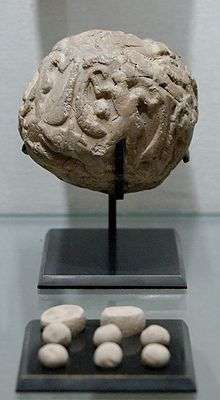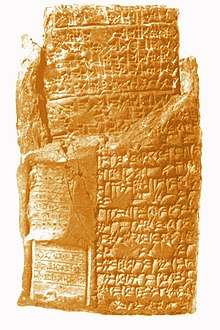History of ancient numeral systems
Numeral systems have progressed from the use of tally marks, more than 40,000 years ago, through to the use of sets of glyphs to efficiently represent any conceivable number.
Pre-history
The first method of counting has been argued to be counting on fingers.[1] This evolved into sign language for the hand-to-eye-to-elbow communication of numbers which, while not writing, gave way to written numbers.
Tallies made by carving notches in wood, bone, and stone were used for at least forty thousand years.[2][3] These tally marks may have been used for counting elapsed time, such as numbers of days, lunar cycles or keeping records of quantities, such as of animals.
Lebombo bone is a baboon fibula with incised markings discovered in the Lebombo Mountains located between South Africa and Swaziland. The bone is between 44,230 and 43,000 years old, according to two dozen radiocarbon datings. According to The Universal Book of Mathematics the Lebombo bone's 29 notches suggest "it may have been used as a lunar phase counter, in which case African women may have been the first mathematicians, because keeping track of menstrual cycles requires a lunar calendar." But the bone is clearly broken at one end, so the 29 notches can only be a minimum number. Furthermore, in the many more notched bones since found there is no consistent notch tally, many being in the 1–10 range.
Ishango bone is an artifact with a sharp piece of quartz affixed to one end, perhaps for engraving. It was first thought to be a tally stick, as it has a series of what has been interpreted as tally marks carved in three columns running the length of the tool. But some scientists have suggested that the groupings of notches indicate a mathematical understanding that goes beyond counting. It has also been suggested that the scratches might have been to create a better grip on the handle or for some other non-mathematical reason. It is believed that the bone is more than 20,000 years old.[4][5]
Clay token

The earliest known writing for record keeping evolved from a system of counting using small clay tokens. The earliest tokens now known are those from two sites in the Zagros region of Iran: Tepe Asiab and Ganj-i-Dareh Tepe.[6]
To create a record that represented "two sheep", they selected two round clay tokens each having a + sign baked into it. Each token represented one sheep. Representing a hundred sheep with a hundred tokens would be impractical, so they invented different clay tokens to represent different numbers of each specific commodity, and by 4000 BC strung the tokens like beads on a string.[7] There was a token for one sheep, a different token for ten sheep, a different token for ten goats, etc. Thirty-two sheep would be represented by three ten-sheep tokens followed on the string by two one-sheep tokens.
To ensure that nobody could alter the number and type of tokens, they invented a clay envelope shaped like a hollow ball into which the tokens on a string were placed, sealed, and baked. If anybody disputed the number, they could break open the clay envelope and do a recount. To avoid unnecessary damage to the record, they pressed archaic number signs and witness seals on the outside of the envelope before it was baked, each sign similar in shape to the tokens they represented. Since there was seldom any need to break open the envelope, the signs on the outside became the first written language for writing numbers in clay. An alternative method was to seal the knot in each string of tokens with a solid oblong bulla of clay having impressed symbols, while the string of tokens dangled outside of the bulla.[8]
Beginning about 3500 BC the tokens and envelopes were replaced by numerals impressed with a round stylus at different angles in flat clay tablets which were then baked.[9] A sharp stylus was used to carve pictographs representing various tokens. Each sign represented both the commodity being counted and the quantity or volume of that commodity.
Abstract numerals, dissociated from the thing being counted, were invented about 3100 BC.[10] The things being counted were indicated by pictographs carved with a sharp stylus next to round-stylus numerals.
The Sumerians had a complex assortment of incompatible number systems, and each city had its own local way of writing numerals. For instance, at about 3100 BC in the city of Uruk, there were more than a dozen different numeric systems.[11] In this city, there were separate number systems for counting discrete objects (such as animals, tools, and containers), cheese and grain products, volumes of grain (including fractions), beer ingredients, weights, land areas, and time and calendar units. Furthermore, these systems changed over time; for instance, numbers for counting volumes of grain changed when the size of the baskets changed.
The Sumerians invented arithmetic.[12] People who added and subtracted volumes of grain every day used their arithmetic skills to count other things that were unrelated to volume measurements. Multiplication and division were done with multiplication tables baked in clay tablets.[13]
Conversion of archaic numbers to cuneiform

Between 2700 BC and 2000 BC, the round stylus was gradually replaced by a reed stylus that had been used to press wedge shaped cuneiform signs in clay. To represent numbers that previously had been pressed with a round stylus, these cuneiform number signs were pressed in a circular pattern and they retained the additive sign-value notation that originated with tokens on a string. Cuneiform numerals and archaic numerals were ambiguous because they represented various numeric systems that differed depending on what was being counted. About 2100 BC in Sumer, these proto-sexagesimal sign-value systems gradually converged on a common sexagesimal number system that was a place-value system consisting of only two impressed marks, the vertical wedge and the chevron, which could also represent fractions.[14] This sexagesimal number system was fully developed at the beginning of the Old Babylonia period (about 1950 BC) and became standard in Babylonia.
Sexagesimal numerals were a mixed radix system that retained the alternating base 10 and base 6 in a sequence of cuneiform vertical wedges and chevrons. Sexagesimal numerals became widely used in commerce, but were also used in astronomical and other calculations. This system was exported from Babylonia and used throughout Mesopotamia, and by every Mediterranean nation that used standard Babylonian units of measure and counting, including the Greeks, Romans and Syrians. In Arabic numerals, we still use sexagesimal to count time (minutes per hour), and angles (degrees).
Roman numerals
Roman numerals evolved from this primitive system of cutting notches.[15] It was once believed that they came from alphabetic symbols or from pictographs, but these theories have been disproved.[16][17]
See also
External links
Footnotes
- ↑ The Earliest Calculating – The Hand, Ifrah (2000), pages 47–61.
- ↑ Tally Sticks, Ifrah (2000), pages 64–67.
- ↑ Marshack, A., The Roots of Civilisation; Cognitive Beginnings of Man’s First Art, Symbol and Notation, (Weidenfeld & Nicolson, London: 1972), 81ff.
- ↑ Marshack, Alexander (1991): The Roots of Civilization, Colonial Hill, Mount Kisco, NY.
- ↑ Brooks, A.S. and Smith, C.C. (1987): "Ishango revisited: new age determinations and cultural interpretations", The African Archaeological Review, 5 : 65–78.
- ↑ http://en.finaly.org/index.php/Two_precursors_of_writing:_plain_and_complex_tokens
- ↑ How Writing Came About, Strings of Tokens and Envelopes, Besserat (1996) pages 39–54.
- ↑ String of tokens sealed with a bulla of clay
- ↑ Impressed Tablets, Besserat (1996) pages 55–62.
- ↑ Tokens, Their Role in Prehistory, Besserat (1996) pages 123–124.
- ↑ Archaic Numerical Sign Systems, Nissen (1993) pages 25–29.
- ↑ The Development of Arithmetic, Nissen (1993) pages 125–127.
- ↑ Picture of a multiplication table, Nissen (1993) pages 144–145.
- ↑ Sexagesimal Place Value System, Nissen (1993) pages 142–143.
- ↑ The Origin of Roman Numerals, Ifrah (2000), pages 191–194.
- ↑ Paul Keyser, "The origin of the Latin numerals 1 to 1000 , American Journal of Archeology 92 (1988), pp. 529–546.
- ↑ Stephen Chrisomalis, Numerical Notation: A Comparative History (2010).
References
- Denise Schmandt-Besserat HomePage, How Writing Came About, University of Texas Press, 1996, ISBN 0-292-77704-3.
- Georges Ifrah. The Universal History of Numbers: From Prehistory to the Invention of the Computer, Wiley, 2000. ISBN 0-471-37568-3.
- Hans J. Nissen, P. Damerow, R. Englund, Archaic Bookkeeping, University of Chicago Press, 1993, ISBN 0-226-58659-6.